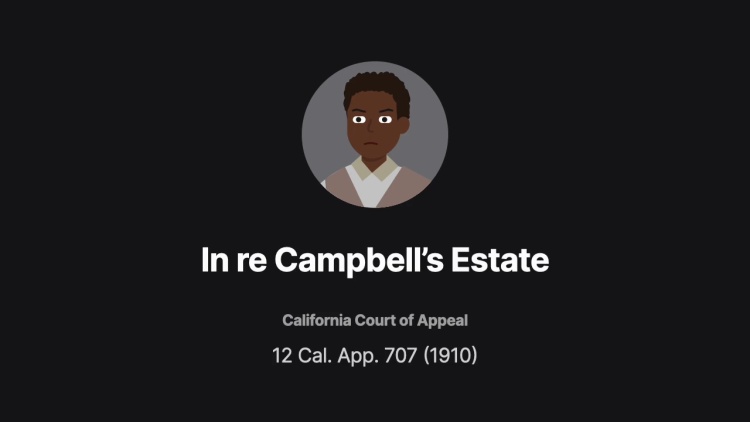In re Campbell’s Estate
California Court of Appeal
12 Cal. App. 707 (1910)

- Written by Kelli Lanski, JD
Facts
Basil Campbell, a former slave, died, and G. Wyatt Wheeler and John W. Wheeler (plaintiffs) claimed the right to an inheritance from his estate as his sons from a legitimate marriage. Under California law, only children from legitimate marriages were entitled to inherit unless the father had acknowledged paternity in writing. Campbell had never acknowledged that he was the father of Wyatt or John, so their right to an inheritance hinged on whether Campbell had married their mother, Mary Stephens. Wyatt and John presented evidence that Campbell had had what was known as a slave marriage to Stephens. A slave marriage occurred when two slaves asked for permission from their owner to wed. If granted permission, they would live together and might have children. The marriage could end as informally as it began, and it was understood that if one slave in a marriage was sold or moved out of state, the marriage ended. Campbell was born a slave in Missouri in 1830. He was alleged to have married Stephens when he was around 18 while they lived with the same owner. At the time, Stephens had already been married to another slave. In 1854, Campbell went to California with the husband of his owner, and he did not communicate with Stephens after that point. Campbell eventually became free and remarried. The court rejected Wyatt and John’s claim, and they appealed.
Rule of Law
Issue
Holding and Reasoning (Chipman, C.J.)
What to do next…
Here's why 899,000 law students have relied on our case briefs:
- Written by law professors and practitioners, not other law students. 47,000 briefs, keyed to 994 casebooks. Top-notch customer support.
- The right amount of information, includes the facts, issues, rule of law, holding and reasoning, and any concurrences and dissents.
- Access in your classes, works on your mobile and tablet. Massive library of related video lessons and high quality multiple-choice questions.
- Easy to use, uniform format for every case brief. Written in plain English, not in legalese. Our briefs summarize and simplify; they don’t just repeat the court’s language.





